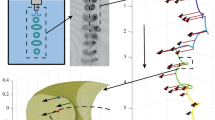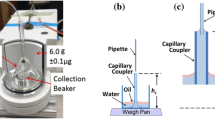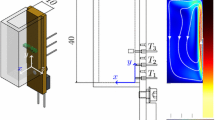Abstract
Current experiment techniques for vorticity measurement suffer from limited spatial and temporal resolution to resolve the small-scale eddy dynamics in turbulence. In this study, we develop a new method for direct vorticity measurement in fluid flows based on digital inline holography (DIH). The DIH system utilizes a collimated laser beam to illuminate the tracers with internal markers and a digital sensor to record the generated holograms. The tracers made of the polydimethylsiloxane prepolymer mixed with internal markers are fabricated using a standard microfluidic droplet generator. A rotation measurement algorithm is developed based on the 3D location reconstruction and tracking of the internal markers and is assessed through synthetic holograms to identify the optimal parameter settings and measurement range (e.g., rotation rate from 0.3 to 0.7 rad/frame under numerical aperture of imaging of 0.25). Our proposed method based on DIH is evaluated by a calibration experiment of single tracer rotation, which yields the same optimal measurement range. Using von Kármán swirling flow setup, we further demonstrate the capability of the approach to simultaneously measure the Lagrangian rotation and translation of multiple tracers. Our method can measure vorticity in a small region on the order of 100 µm or less and can be potentially used to quantify the Kolmogorov-scale vorticity field in turbulent flows.
Graphical abstract








Similar content being viewed by others
References
Allan DB, Caswell T, Keim NC, Wel van der CM (2018) trackpy: Trackpy v0. 4.1. Zenodo. CERN, Geneva, Switzerland
Brady DJ, Choi K, Marks DL, Horisaki R, Lim S (2009) Compressive holography. Opt Express 17(15):13040–13049
Byeon H, Go T, Lee SJ (2016) Precise measurement of orientations of transparent ellipsoidal particles through digital holographic microscopy. Opt Express 24(1):598–610
Cai S, Liang J, Gao Q, Xu C, Wei R (2019) Particle image velocimetry based on a deep learning motion estimator. IEEE Trans Instrum Meas 69(6):3538–3554
Cardesa JI, Vela-Martín A, Jiménez J (2017) The turbulent cascade in five dimensions. Science 357(6353):782–784
Carneiro J, Doutel E, Campos JBLM, Miranda JM (2016) PDMS droplet formation and characterization by hydrodynamic flow focusing technique in a PDMS square microchannel. J Micromech Microeng 26(10):105013
Cheong FC, Grier DG (2010) Rotational and translational diffusion of copper oxide nanorods measured with holographic video microscopy. Opt Express 18(7):6555–6562
Chwang AT, Wu TYT (1974) Hydromechanics of low-Reynolds-number flow. Part 1. Rotation of axisymmetric prolate bodies. J Fluid Mech 63(3):607–622
Elsas JH, Szalay AS, Meneveau C (2018) Geometry and scaling laws of excursion and iso-sets of enstrophy and dissipation in isotropic turbulence. J Turbul 19(4):297–321
Elsinga GE, Marusic I (2010) Universal aspects of small-scale motions in turbulence. J Fluid Mech 662:514–539
Endo Y, Shimobaba T, Kakue T, Ito T (2016) GPU-accelerated compressive holography. Opt Express 24(8):8437–8445
Frish MB, Webb WW (1981) Direct measurement of vorticity by optical probe. J Fluid Mech 107:173–200
Guala M, Lüthi B, Liberzon A, Tsinober A, Kinzelbach W (2005) On the evolution of material lines and vorticity in homogeneous turbulence. J Fluid Mech 533:339–359
Guala M, Hommema SE, Adrian RJ (2006) Large-scale and very-large-scale motions in turbulent pipe flow. J Fluid Mech 554:521–542
Ilg E, Mayer N, Saikia T, Keuper M, Dosovitskiy A, Brox T (2017) Flownet 2.0: evolution of optical flow estimation with deep networks. In; Proceedings of the IEEE conference on computer vision and pattern recognition, pp 2462–2470
Jiang K, Thomas PC, Forry SP, DeVoe DL, Raghavan SR (2012) Microfluidic synthesis of monodisperse PDMS microbeads as discrete oxygen sensors. Soft Matter 8(4):923–926
Jiménez J (1999) The physics of wall turbulence. Physica A 263(1–4):252–262
Jiménez J, Wray AA, Saffman PG, Rogallo RS (1993) The structure of intense vorticity in isotropic turbulence. J Fluid Mech 255:65–90
Jolivet F, Momey F, Denis L, Méès L, Faure N, Grosjean N, Pinston F, Marié J-L, Fournier C (2018) Regularized reconstruction of absorbing and phase objects from a single in-line hologram, application to fluid mechanics and micro-biology. Opt Express 26(7):8923–8940
Katz J, Sheng J (2010) Applications of holography in fluid mechanics and particle dynamics. Annu Rev Fluid Mech 42:531–555
Klein S, Gibert M, Bérut A, Bodenschatz E (2012) Simultaneous 3D measurement of the translation and rotation of finite-size particles and the flow field in a fully developed turbulent water flow. Meas Sci Technol 24(2):024006
Kumar SS, Huang X, Yang X, Hong J (2021) Three dimensional flow motions in the viscous sublayer. Theor Appl Mech Lett 11(2):100239
Lozano-Durán A, Jiménez J (2014) Time-resolved evolution of coherent structures in turbulent channels: characterization of eddies and cascades. J Fluid Mech 759:432–471
Mallery K, Hong J (2019) Regularized inverse holographic volume reconstruction for 3D particle tracking. Opt Express 27(13):18069–18084
Marcus GG, Parsa S, Kramel S, Ni R, Voth GA (2014) Measurements of the solid-body rotation of anisotropic particles in 3D turbulence. New J Phys 16(10):102001
Markley FL, Mortari D (2000) Quaternion attitude estimation using vector observations. J Astronaut Sci 48(2):359–380
Oh JK, Drumright R, Siegwart DJ, Matyjaszewski K (2008) The development of microgels/nanogels for drug delivery applications. Prog Polym Sci 33(4):448–477
Pradeep DS, Hussain F (2010) Vortex dynamics of turbulence–coherent structure interaction. Theoret Comput Fluid Dyn 24(1):265–282
Rogers MM, Moin P (1987) The structure of the vorticity field in homogeneous turbulent flows. J Fluid Mech 176:33–66
Ryabtsev A, Pouya S, Safaripour A, Koochesfahani M, Dantus M (2016) Fluid flow vorticity measurement using laser beams with orbital angular momentum. Opt Express 24(11):11762–11767
Schoppa W, Hussain F (2000) Coherent structure dynamics in near-wall turbulence. Fluid Dyn Res 26(2):119
Schoppa W, Hussain F (2002) Coherent structure generation in near-wall turbulence. J Fluid Mech 453:57–108
She ZS, Jackson E, Orszag SA (1990) Intermittent vortex structures in homogeneous isotropic turbulence. Nature 344(6263):226–228
Sheng J, Malkiel E, Katz J (2009) Buffer layer structures associated with extreme wall stress events in a smooth wall turbulent boundary layer. J Fluid Mech 633:17–60
Sreenivasan KR, Antonia RA (1997) The phenomenology of small-scale turbulence. Annu Rev Fluid Mech 29(1):435–472
Tan S, Salibindla A, Masuk AUM, Ni R (2019) An open-source shake-the-box method and its performance evaluation. In:13th international symposium on particle image velocimetry
Teed Z, Deng J (2020) Raft: recurrent all-pairs field transforms for optical flow. In: European conference on computer vision, Springer, Cham, pp 402–419
Toloui M, Hong J (2015) High fidelity digital inline holographic method for 3D flow measurements. Opt Express 23(21):27159–27173
Toloui M, Mallery K, Hong J (2017) Improvements on digital inline holographic PTV for 3D wall-bounded turbulent flow measurements. Meas Sci Technol 28(4):044009
Tropea C, Yarin AL, Foss JF (2007) Springer handbook of experimental fluid mechanics, vol 1. Springer, Berlin, pp. 237
Verrier N, Grosjean N, Dib E, Méès L, Fournier C, Marié JL (2016) Improvement of the size estimation of 3D tracked droplets using digital in-line holography with joint estimation reconstruction. Meas Sci Technol 27(4):045001
Wahba G (1965) A least squares estimate of satellite attitude. SIAM Rev 7(3):409–409
Wu Y, Wu X, Yao L, Brunel M, Coëtmellec S, Lebrun D, Gréhan G, Cen K (2015) Simultaneous measurement of 3D velocity and 2D rotation of irregular particle with digital holographic particle tracking velocimetry. Powder Technol 284:371–378
Wu H, Xu H, Bodenschatz E (2018) U.S. Patent No. 9,961,328. U.S. Patent and Trademark Office, Washington, DC
Xu W, Jericho MH, Meinertzhagen IA, Kreuzer HJ (2001) Digital in-line holography for biological applications. Proc Natl Acad Sci 98(20):11301–11305
Yang Y, Pullin DI, Bermejo-Moreno I (2010) Multi-scale geometric analysis of Lagrangian structures in isotropic turbulence. J Fluid Mech 654:233–270
You J, Mallery K, Mashek DG, Sanders M, Hong J, Hondzo M (2020) Microalgal swimming signatures and neutral lipids production across growth phases. Biotechnol Bioeng 117(4):970–980
Zimmermann R, Gasteuil Y, Bourgoin M, Volk R, Pumir A, Pinton JF (2011a) Tracking the dynamics of translation and absolute orientation of a sphere in a turbulent flow. Rev Sci Instrum 82(3):033906
Zimmermann R, Gasteuil Y, Bourgoin M, Volk R, Pumir A, Pinton JF (2011b) Rotational intermittency and turbulence induced lift experienced by large particles in a turbulent flow. Phys Rev Lett 106(15):154501
Acknowledgments
This study is supported by the Army Research Office (Program Manager, Dr. Matthew Munson) under the award No.W911NF2010098. The authors would like to thank Keven Mallery, Tong Zhou, and Rafael Grazzini Placucci for their help and support during the course of this research.
Author information
Authors and Affiliations
Corresponding author
Additional information
Publisher's Note
Springer Nature remains neutral with regard to jurisdictional claims in published maps and institutional affiliations.
Appendices
Appendix
Appendix 1
The von Kármán swirling flow can be described by the equations below (Eqs. 2, 3, 4 and 5), assuming steady flow as the image data is taken long enough after turning on the motor
with the boundary conditions for fluid with \(z > 0\):
In these equations, \(\left( {u,v,w} \right)\) are the velocity components in cylindrical coordinates \(\left( {r,\theta ,z} \right)\), with the origin at the center of the spinning disk and \(\left( {r,\theta } \right)\) representing the plane parallel to the disk. Note that the coordinate system is defined in a way different from that of the image data. The cross section of the measurement sample volume is around 6.6 mm × 3.7 mm, much smaller compared to the size of the flow chamber, and it is only around one-fifth of the diameter of the disk. With the small sample volume, it is safe to assume that the boundaries of the flow chamber have little influence on the flow in the measurement volume and there is no rotation at infinity. Thus, the pressure becomes independent of \(r\). By introducing the transformation: \(\eta = \sqrt {\frac{\Omega }{\nu }} z\), \(u = r\Omega F\left( \eta \right)\), \(v = r\Omega G\left( \eta \right)\), \(w = \sqrt {\nu \Omega } H\left( \eta \right)\), \(p = p_{0} + \rho \nu \Omega P\left( \eta \right)\), where \(\nu\) is the kinematic viscosity of the fluid, and \(\Omega\) is the angular speed of the spinning disk, the self-similar equations (Eqs. 6, 7, 8 and 9) can be derived:
and the boundary conditions for fluid with \(\eta > 0\) are now:
Moreover, the vorticity components in the cylindrical coordinates can also be derived as follows:
The self-similar equations (Eqs. 6, 7 and 8) are numerically solved using the bvp4c function in MATLAB to obtain the profiles of functions \(F\), \(G\), and \(H\) as well as the derivatives \(F^{\prime}\) and \(G^{\prime}\). By applying \(\nu = 9.5 \times 10^{ - 6} \ {\text{m}}^{2} /{\text{s}}\) and \(\Omega = 198 \ {\text{rad}}/{\text{s}}\) to the equations for \(\left( {u,v,w} \right)\) and \(\left( {\omega_{r} ,\omega_{\theta } ,\omega_{z} } \right)\), the analytical velocity and vorticity fields can be derived. To compare with the measurement, the vorticity is converted to rotation rate by dividing two times of the imaging frame rate as the vorticity is twice the angular velocity.
Rights and permissions
Springer Nature or its licensor holds exclusive rights to this article under a publishing agreement with the author(s) or other rightsholder(s); author self-archiving of the accepted manuscript version of this article is solely governed by the terms of such publishing agreement and applicable law.
About this article
Cite this article
Li, J., Feng, L., Panigrahi, C. et al. Direct measurement of vorticity using tracer particles with internal markers. Exp Fluids 63, 161 (2022). https://doi.org/10.1007/s00348-022-03510-w
Received:
Revised:
Accepted:
Published:
DOI: https://doi.org/10.1007/s00348-022-03510-w




